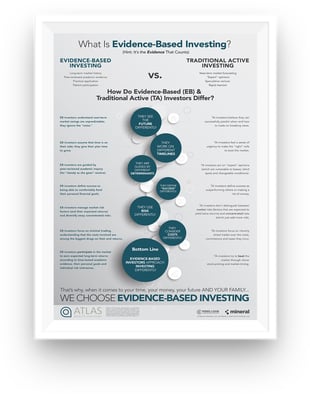4 min read
7 Principles to Help You Plan for Retirement Like a Pro: Principle #5: 3 Steps to Help You Invest Wisely for Retirement
By: Atlas Wealth Advisors on Jul 5, 2017 9:41:58 AM

Investing for your retirement journey is a lifelong endeavor, and – like any other journey – it involves some risk. How you approach investing for retirement directly affects whether you reach the destination you truly want or find yourself stuck on a detour to nowhere.
Here are three steps you can take to ensure your retirement planning takes you on the retirement journey you are planning for:
Step 1: Prioritize Your Retirement Goals
This initial step might seem simple enough but often requires some thought and guidance to commit your thoughts from pen to paper. This step is simple because it relies on information that you already possess - your unique goals for retirement. However, prioritizing your goals in relation to each other, and in relation to the person you are planning on retiring with, may take some additional consideration and collaboration.
To get started, consider how would you prioritize these retirement goals:
Traveling
If you’ve often thought of spending more time in places you have visited on vacation, or if you have dreamed of traveling to new areas of countries you have already visited, then saving for more traveling in retirement is a no-brainer. On the other hand, you might want to combine having the time to travel with visiting family, so you might be staying closer to home but still getting out to see your loved ones at your leisure. Some might want to do both, spend more time with their extended friends and family and see more of the world.
Paying for Your Grandchildren’s College
One of the joys in retirement is sharing the wealth you have worked so hard to build and maintain. You have probably made a lot of sacrifices in the short term to put yourself in a position to be able to help your children with major expenses later in their lives. One example of this would be paying for your grandchildren’s college tuition. You might even want to help pay for elementary or secondary school costs, or you might want to pitch in for part of these expenses. Either way, it’s your choice depending on your goals and values. With proper planning, you can make those goals a reality for you and your family.
Starting a Business
If you’ve always dreamed of starting your own business in retirement, then it’s important to make this goal official by making the appropriate plans now so you can finally execute this life-long vision. This goal isn’t for everyone, but for some people retirement isn’t about not working, it’s about doing the work you chose when you chose to do it.
Step 2: Put your goals on a timeline
You’ve often heard financial professionals say that younger people can handle more risk than middle-aged individuals when investing for retirement. But general rules don’t matter as much as the timeline for your individual goals. Keep in mind that all investing – for retirement and otherwise – is the business of taking measured risks for the possible gains that may come.
When you prioritize your retirement goals, and figure out when you want to be able to achieve them, you can make well-informed decisions about how to fund those goals.
EXAMPLE:
If one of your goals is to assist your grandchildren with their college education expenses, the timeline for achieving that goal can affect how you would plan. If you’re about to retire and your grandchildren are all under the age of five, you have some time to invest in their college funds. If they’re teenagers, you might need to plan differently.
No matter where you are in your life journey, you’ll want to make sure you have priorities and benchmarks in place so that you know how far you’ve progressed on your retirement map.
Step 3: Take an evidence-based approach to investing
The third and final step we recommend for investing in your retirement journey is to adopt an evidence-based approach. Evidence-based investing involves taking a less subjective, more systematic approach to investing. Rather than chasing returns by jumping from investment to investment, evidence-based investing is a highly disciplined approach to investing that is grounded in economic theory and backed by decades of empirical research.
Ask ten wealth management firms to define wealth management, and you will almost certainly get ten different answers—with most heavily focused on investing. Forecasting returns or market trends can be a futile exercise in trying to outguess others. Trying to pick a manager that can successfully pick stocks can result in negative tax consequences from moving in and out of funds, and often results in higher fees for the investor due to the commissions the fund managers get.
Your financial journey can be fraught with uneven terrain and unexpected hurdles. Using an evidence-based strategy can keep you on course. See the difference between Evidence-Based Investing and Traditional Active Investing.
Your Wealth Perspective
We understand taking this process can be daunting. It is often easier to know what matters most than it is to figure out what matters second most, and so on. Also, your past and perception of the world influences your goals and how you communicate those goals to others. To make this process easier and more meaningful for you, take a few minutes to discover your Wealth Perspective right now.
Once you know your Wealth Perspective, you can start to establish a retirement plan based on relevant goals that are focused on what matters most to you because they incorporate your personality.
Travel Ready
By knowing your wealth perspective, and taking the three steps to help you invest wisely for retirement, you will be much closer to turning your retirement dream journey into your real-life adventure. There are sure to be some twists and turns along the way, but with a solid plan financial map you’ll have the navigation tools required to get you where you’re headed.
Related Posts
7 Principles to Help You Plan for Retirement Like a Pro: Principle #7: Spend and Invest Realistically
3 Retirement Spending Tips for the Road
Our principles thus far have been largely about preparing...
7 Principles of Retirement Planning: Principle 1 - Begin with a Map
Any good traveler knows that a journey, at its most basic, is defined by two things: a starting...
Social Security and Retirement Income – Navigating the New Rules
When you enter a new phase of life, people love to offer you advice on the first thing to do when...



